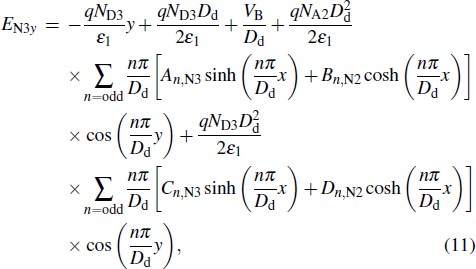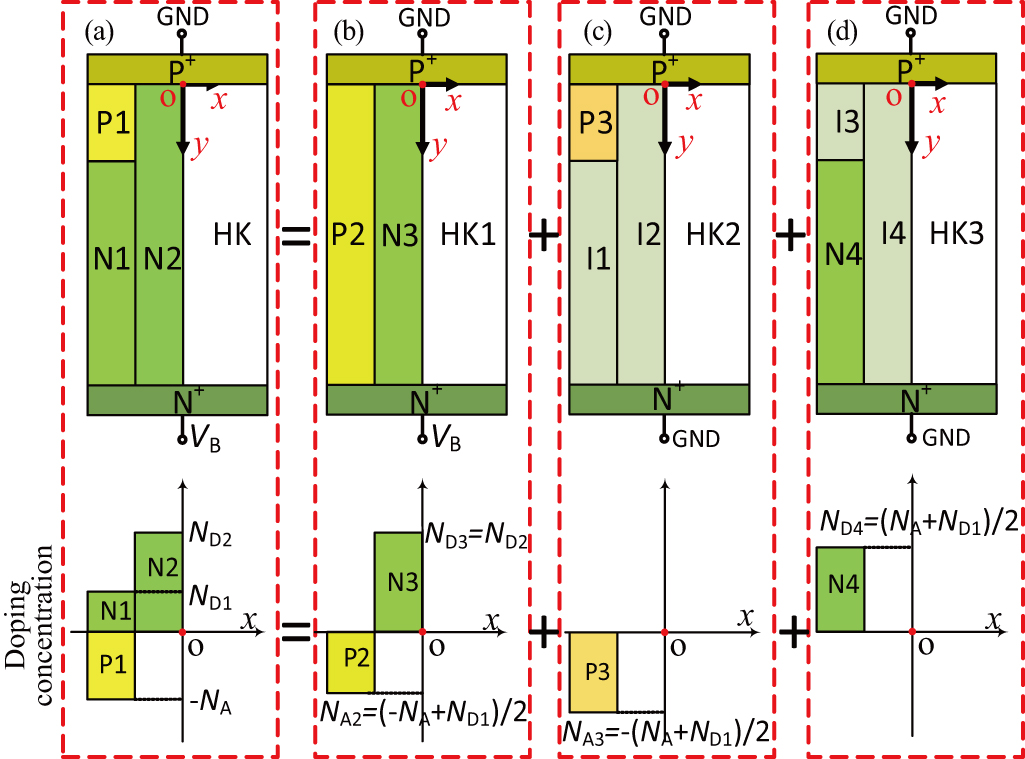Project supported by the National Natural Science Foundation of China (Grant No. 61404110) and the National Higher-education Institution General Research and Development Project, China (Grant No. 2682014CX097).
Project supported by the National Natural Science Foundation of China (Grant No. 61404110) and the National Higher-education Institution General Research and Development Project, China (Grant No. 2682014CX097).
† Corresponding author. E-mail:
Project supported by the National Natural Science Foundation of China (Grant No. 61404110) and the National Higher-education Institution General Research and Development Project, China (Grant No. 2682014CX097).
An improved vertical power double-diffused metal–oxide–semiconductor (DMOS) device with a p-region(P1) and high-κ insulator vertical double-diffusion metal–oxide–semiconductor (HKP-VDMOS) is proposed to achieve a better performance on breakdown voltage (BV)/specific on-resistance (Ron,sp) than conventional VDMOS with a high-κ insulator (CHK-VDMOS). The main mechanism is that with the introduction of the P-region, an extra electric field peak is generated in the drift region of HKP-VDMOS to enhance the breakdown voltage. Due to the assisted depletion effect of this p-region, the specific on-resistance of the device could be reduced because of the high doping density of the N-type drift region. Meanwhile, based on the superposition of the depleted charges, a closed-form model for electric field/breakdown voltage is generally derived, which is in good agreement with the simulation result within 10% of error. An HKP-VDMOS device with a breakdown voltage of 600 V, a reduced specific on-resistance of 11.5 mΩ·cm2 and a figure of merit (FOM) (BV2/Ron,sp) of 31.2 MW·cm−2 shows a substantial improvement compared with the CHK-VDMOS device.
Vertical double-diffused metal–oxide–semiconductor (VDMOS) device using a high-κ (HK) insulator has been investigated for power application,[1–5] owing to a much higher permittivity of the HK insulator for absorbing most electric displacement lines instead of the semiconductor drift region. Therefore, it could achieve a superior trade-off relationship between breakdown voltage (BV) and specific on-resistance (Ron,sp).[6–10] This trade-off scenario is similar to a super junction by optimizing the drift region. An analytical model of a conventional VDMOS with the HK insulator (CHK-VDMOS) is derived to calculate the electric field and BV.[1] Based on this model, it is noted that the potential contours in the drift region are not so uniformly distributed as in a super junction. The avalanche breakdown point is yielded in the source-side drift region. Optimization of electric field in the drift region of CHK-VDMOS can further minimize Ron,sp at a maximum BV by modulating electric field flux into the HK insulator.[11]
Based on intrinsic absorption of electric displacement in the HK voltage sustained layer, an improved vertical power DMOS device with a p-region and an HK insulator (HKP-VDMOS) is proposed. Taking the superposition principle of charge conservation into account for simplification,[13–15] a closed-form analytical model is built for the electric field distribution and the breakdown voltage. This model is to reveal how the extra electric field peak in the bulk of the drift region is affected by space charges.
Figure
| Table 1. Device parameters used in Medici simulation. . |
In this subsection, an analytical model of breakdown voltage/specific on-resistance of the HKP-VDMOS is derived. In order to carry out derivation, the HKP-VDMOS is decomposed into three cell units — each cell unit could be represented by a diode as shown in Fig.
To construct an analytical model as given in Figs.
(i) When breakdown occurs, the drift region is assumed to be in the punching-through condition and hence fully depleted for simplifying three unit cells with decomposed charge based on the charge superposition principle.
(ii) The cell units as shown in Figs.
(iii) In the P–I–HK and the N–I–HK cell units, the potential from the upper side to the lower side is assumed to be zero and the contributions of the ionized regions of P3 and N4 to the static electric fields in the vertical direction considering the path integration are both zero.
Assuming that the whole drift region is fully depleted, the Poisson equations for superposition are generally simplified as
 |
 |
 |
 |
 |
 |
 |
i) In the N3-region of Fig. 
 |
ii) In the I2-region of Fig. 
 |
iii) In the I4-region of Fig. 
 |
Based on the charge superposition technique and Eijy = ∂Vij/∂y, the superpositions of the y-components of the electric fields, as seen in Figs.
 |
 |
 |
Figure
The values of ΔEy (ΔEy = Ey, HKP − Ey, CHK) and ΔBVy (ΔBVy = BVy, HKP − BVy, CHK) ΔBVy at the locations x = −0.5 μm and x = −3 μm are shown in Fig.
Based on the aforementioned Poisson solution, the breakdown voltage can be calculated along the avalanche breakthrough path. The avalanche breakdown condition is given as 
The y-component of the electric field in the device is generally affected by the P-region. The optimized breakdown voltage (BV/V) could be approximated by
 |
| Table 2.
Correlation coefficients. . |
Using the relationship between the resistivity and the doping concentration, the ideal on-resistance equation could be rewritten as follows:[16]
 |
 |
 |
| Table 3.
Correlation coefficients. . |
BV and Ron,sp are closely related to the doping concentrations of the drift region and P-region. In addition, BV is strongly related to the permittivity of the HK insulator. Therefore, the optimized breakdown voltage and specific on-resistance could be predicted by Eqs. (
The theoretical and simulated results of BV and Ron,sp are each as a function of ND2 in HKP-VDMOS and CHK-VDMOS are shown in Fig.
Figure
Figure
Figure
| Table 4.
Optimized values of the HKP-VDMOS device and the CHK-VDMOS device. . |
| Table 5.
Optimized values of the HKP-VDMOS device and the CHK-VDMOS device. . |
An improved vertical power MOSFET with p-region and HK insulator has been proposed and investigated. A P-region is introduced into the drift region for enhancing BV and reducing Ron,sp. Hence, a much higher FOM of HKP-VDMOS than that of CHK-CDMOS can be obtained. The simulation results show that the improved device enables a 16.7% reduction in Ron,sp, and 18% improvement in FOM under the same breakdown voltage (BV), compared with the CHK-VDMOS. An analytical model of the HKP-VDMOS is also derived, and presents the results in good agreement with simulated results.
| [1] | |
| [2] | |
| [3] | |
| [4] | |
| [5] | |
| [6] | |
| [7] | |
| [8] | |
| [9] | |
| [10] | |
| [11] | |
| [12] | |
| [13] | |
| [14] | |
| [15] | |
| [16] | |
| [17] | |
| [18] | |
| [19] | |
| [20] | |
| [21] |











